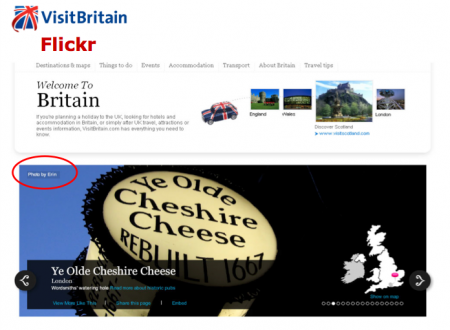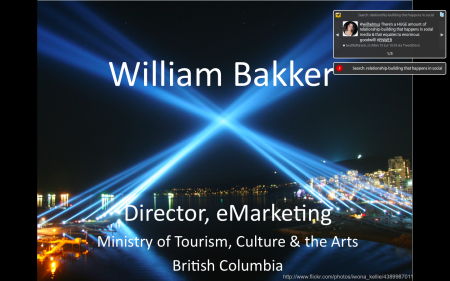The Archives
-
Internet, Marketing, Travel & Tourism
Take-aways from VisitBritain’s social media presentation

Somebody emailed me this webcast where Justin Reid from VisitBritain shares their social media strategy, examples, results and learning. Very insightful. Here are my key take-aways.
People don’t make a travel decision on a national tourism board website
Justin said: “Our research told us that the majority of long haul travelers visit a national tourist board after they’ve already made the decision to visit”
VisitBritain’s rightly concluded that in order to target people in the decision making process, they need to engage in other places like third party websites. A content partnership with Yahoo is working very well for them for example.
The future of CRM/eMail Marketing is under threat
Justin said: “Where previously you might have focused a lot of CRM activity we learned that the inbox is no longer a happy place. People want to clear it out as fast as possible. So we now want to focus on finding places where people are in the mindset of making decisions about travel [social media].”
I wondered about the same thing about a year ago in this blog post. As people become overwhelmed with email, they pay less attention to marketing messages, even when they opt-in. This kind of change won’t happen overnight but social media is an environment where people are easier to engage, two-way dialogue is possible and content is easy to share.
Social Media’s network effect has incredible reach
Justin: “10,000 followers is amazing. But we followed the traffic of some of our tweets and each of our tweets reaches a potential audience of about 325,000 people”
Through re-tweets on Twitter, and by tagging and sharing on Facebook, a message can travel far and wide in a very short period of time. And the content itself is much more credible because it’s endorsed by a friend who shared it.
Tourism Australia’s fanpage with over 600,000 fans is a good example. Every message they posts could be read by that many people. And for every person that comments on the post, the post gets published to their friend network, extending reach with the potential to organically grow their fanbase.
And as a side-effect, “Facebook is now the third largest referrer to VisitBritain after Google and Yahoo, and we’re not even seeking to push people to the website.”
Content is far more important than a website
Justin: “Our website is not the most important marketing tool for us, our content is. We’re just as happy if somebody reads our content on Yahoo as on our website.”
VisitBritain is agnostic about where content is being consumed and as a result, more of VisitBritains content is being consumed on third party websites. A partnership with Yahoo produces an exponential amount of views, for free. More videos are viewed than some market websites receive visitors.
Producing or gathering the right content, and pushing it out into place where you add value for the publisher and the consumer, preferably with easy sharing opportunities is much more effective than trying to generate website visitation through advertising alone.
User Generated Content is an easy and cost-effective way to publish content
Justin: “95% of VisitBritain’s photography comes from user generated content” and “when somebody’s photo appears on a national tourism boards site, you can bet on it they will send a link to all their friends to check it out.”
VisitBritain set-up a Flickr group called Love UK and is using it as one of the sources for its photos on VisitBritain.com. And because most people are happy to see their photography used, they will tell everybody about it.. on social media.
Brilliant. This is something I’ve advocated for years but I could never get it going. Well done VisitBritain.
Thanks for sharing Justin!
-
leadership, Management
Must see presentations #5: Itay Talgam: Lead like the great conductors
Don’t tell people how to do things, tell them what to do and let them surprise you with their results.
— George S. PattonI believe that great leaders are passionate people who set a vision and inspire teams and individuals who’ve been given the space to make the vision a reality.
Itay Talgam delivered a great presentation at TED where he uses different styles of symphony conductors to deliver a powerful message about how to lead talented individuals. Very insightful.
-
Internet, Marketing, personal, Travel & Tourism
Presenting with a live twitter feed at PNWER

Today I presented our social media strategy for the 2010 Olympic and Paralympic Games at the PNWER conference in Calgary. One of the things that goes through my mind while I’m presenting these days is “what are people in the audience tweeting about this presentation RIGHT NOW?” Today was different. I could see exactly what was going on.
At the start of my presentation I asked @seattlemaven (who runs Seattle’s Twitter account and was invited to speak but couldn’t be there in person) and the Twitterverse in general a few questions about social media via Twitter. I set-up Tweetdeck notifications and throughout the presentation, answers and comments popped-up on the screen.
The result was organized chaos, but I think it told an interesting story about the power and immediacy of social media. Either way, I had a lot of fun and great feedback from the audience.
Here are the questions I asked and the answers that came by during my presentation.
@seattlemaven When did you start, how many interactions do you have a day on average, and how much time does it take you?
- @wilhelmus Began Soc Med in June 2009. Currently 120K FB fans & nearly 6K Twitter followers. Brings truckloads of positive sentiment! #PNWER
- @wilhelmus Generally I answer between 10-30 ?s in a day. Time allowing, I also ‘jump into’ convos already happening about our city. #PNWER
- @wilhelmus Public tweets approx 10x/day – generates a lot of responses & builds our following AND the essence of Seattle/NW #PNWER
- @wilhelmus 1 hr/day, I’d estimate (but the fun-factor’s HUGE!) :o) #PNWER
@seattlemaven How are you different from a phone or in-person interaction with a consumer?
- seattlemaven: @wilhelmus Twitter allows me to speak to broader audience. 1 public tweet may answer question of 200 followers – that’s powerful! #PNWER
- seattlemaven: @wilhelmus Following me early (B4 arrival) they gain greater sense of area & more comfortable/willing to explore once they arrive. #PNWER
@seattlemaven What’s the best new hot bar in Seattle for a bachelorette party? (audience question)
- seattlemaven:@wilhelmus Pnk Ultralounge opens in a month – we can’t wait! Swanky & hot!!
- seattlemaven:@wilhelmus Amber in Belltown’s hip & fun – great drink specials & a private room that’d knock their socks off!
Tweeps, join me live at a conference. 1) Why should businesses care about social media? #PNWER
- mikalat: @wilhelmus Best advice for social media: figure out where your customers are/what they’re using. Start there, don’t worry about the rest
- seattlemaven: @wilhelmus #1 reason to start SM: People are talking (about you and others) you can either jump into the conversation or not. Do it! #PNWER
- mikalat: @wilhelmus Also – LURK! Read, follow and find out what your competitors are doing and take notes. Learn first, dive in second.
- erikrolfsen: @wilhelmus Don’t be a stranger. Fill out that profile information and do it in a way that will interest people.
2) What’s your #1 piece of advice when starting in social media? #PNWER
- nigel220: @wilhelmus we could learn a lot by listening to our youngest employees when it comes to social media!!
- seattlemaven: @wilhelmus über-important to be authentic — your audience knows canned vs. real! Real = experiences, voice, personality #PNWER
-
Internet
Must see presentations #4: Blaise Aguera y Arcas: Bing’s augmented-reality maps
03.16.10 | Permalink | 3 CommentsI saw Blaise’s first Photosync presentation at Web 2.0 in 2006 and was utterly impressed. He’s now working on Bing maps. This explains why Bing Maps is getting better and better and better.
His presentation at TED recently is a must see.It shows how Bing (and Google) Maps have become so much more than simple mapping tools. And the innovation will continue relentlessly. Let your imagination go wild after watching this presentation. What will Google and/or Bing Maps look like 5 years from now?
-
Internet, social media
Must see presentations #3: Alexis Ohanian: How to make a splash in social media
In less than five minutes you will understand why social media works best when rallying a community behind a common cause, how trying to control the message is of the past, and accepting the wisdom of the crowd can help you achieve your goals, even if this wisdom might seem ridiculous.
-
Internet, Marketing, social media
Must see presentations: #2 Clay Shirky: How social media can make history
12.05.09 | Permalink | 2 CommentsClay Shirky’s powerful presentation at TED earlier this year will combat any Social Media sceptic you might have to deal with in your organization. Do you have key business decission makers who don’t even have a Facebook account, or marketing teams who think Social Media is just another way to broadcast advertising or something viral? In that case, this presentation will explain in 17 minutes that the future of marketing isn’t broadcast but collaboration with your networks of consumers and stakeholders.
-
leadership, Management
Must see lectures #1: Bran Ferren – Leadership
Bran Ferren is the CEO of Applied Minds and the former president of Walt Disney Imagineering, Disney’s R&D division. This lecture is almost 2 hours long and it is very good. While watching this lecture, I put together another piece of the puzzle that reveals the process and methodology we use with Tourism BC’s online team and Rob Munro’s team at technology partner T4G.
My interpretation of Bran’s argument is that there are two types of people; the requirement thinkers and the big idea thinkers. Requirement thinkers are driven by process, documentation and figuring it all out before you start. Big idea thinkers are visionaries, innovators and driven to make things better. To achieve excellence, you need diverse talent and constructive tension to generate a vision, and an aligned team who’re great at implementing using a requirement process but are comfortable with continued evolution. Sounds a lot like our team.
I also like his statement that “consensus based management is the most evil process for destroying innovation I can think off“. I don’t disagree. Although desirable, it often leads to mediocrity or an insane waste of time.
The part I’m referring to runs from minute 24:30 til minute 46:00. There’s more great stuff, you have to watch it.
In another article I found Bran said: “Big-idea companies are run by passionate maniacs who make everybody’s life miserable until they get what they want.”
Guilty as charged. Sort-off.
-
Internet, Marketing
Micro Interactions + Direct Engagement
Brilliant presentation from David Armano’s Logic+Emotion blog. His concepts of Micro Interactions is extremely appropriate for travel. Through research and observation I’ve learned over the last years that a travel decision is often a result of these small and unexpected interactions. The impact of one or more micro interaction can lead to a travel decision. This can be as simple as a blog entry, a picture on Flickr, or a comment on Twitter.
Seth Godin says: “Conversations among the members of your marketplace happen whether you like it or not. Good marketing encourages the right sort of conversations.”


